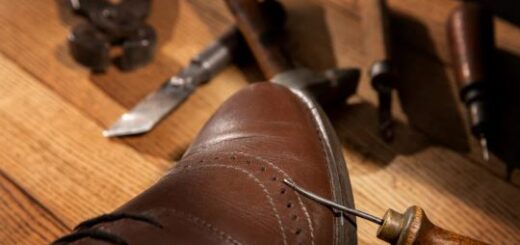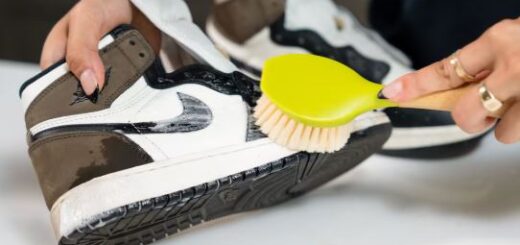Why Some Common Shoe Trees Are Doing More Harm Than Good
Despite modern advancements in footwear care, one outdated accessory remains widespread: the spring-loaded shoe tree. These are still widely used around the world, yet their design does more harm than good. Though originally intended to help maintain the shape and structure of leather shoes, these products often fail in their purpose. In fact, their use can lead to irreversible damage. This article explains why relying on these so-called convenient tools might be compromising the health and longevity of your shoes.
The Illusion of Practicality in Mass-Produced Goods
Today’s consumer market is saturated with items designed more for affordability and broad appeal than actual effectiveness. In the pursuit of keeping prices low, many manufacturers cut corners, sacrificing functionality and long-term quality. The result? Products that only seem helpful on the surface but break down or cause issues with continued use.
This trend is especially noticeable in the world of shoe care. Numerous products, from cheap polishes filled with synthetic additives to plastic tools that offer no real benefit, have flooded the market. Among these are spring-loaded shoe trees, which are often included with store-bought footwear or sold as a budget-friendly “essential.” However, despite their popularity, they are far from ideal.
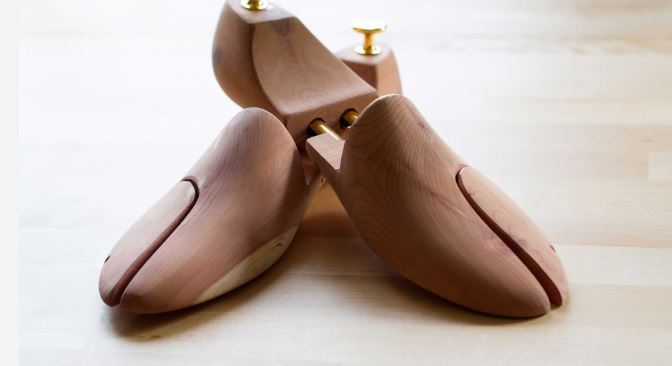
Understanding the Spring-Loaded Shoe Tree
The typical spring-loaded shoe tree includes three components: a front piece shaped vaguely like the toe of a foot, a rigid metal spring connecting the two ends, and a small rounded section that sits at the heel. In many designs, the front half is symmetrical—meaning there’s no differentiation between the left and right foot—although some versions do attempt an asymmetric shape.
These shoe trees are most commonly designed to be “one size fits all,” which in reality means they don’t truly fit any shoe properly. At best, they slightly reduce visible creasing on the vamp. At worst, they actively deform the shoe over time, creating pressure points and structural changes that can significantly reduce the shoe’s lifespan.
How These Designs Cause Structural Damage
When inserting a spring-loaded shoe tree, the spring must be bent to wedge the heel portion into place. This action exerts intense pressure inside the shoe, particularly in two critical areas: the toe box and the heel. Instead of maintaining the shoe’s natural shape, the spring exerts force in unnatural directions. The vamp—the part of the shoe that covers the top of the foot—can be pushed upward as a result, eventually causing the leather to stretch and warp.
This upward tension doesn’t only affect the aesthetics. Over time, it can place unnecessary stress on the welt and stitching, particularly along the flex points where shoes naturally bend. Repeated use of these shoe trees can compromise the integrity of these seams, weakening the construction of the shoe and potentially leading to costly repairs.
The Hidden Threat to the Heel Structure
Perhaps the most overlooked issue with spring-loaded shoe trees is the damage they cause at the heel. The small rear plug or knob doesn’t distribute pressure evenly across the heel counter. Instead, it presses directly into the center of the back portion, which can distort the heel’s shape dramatically.
Shoes with leather board or genuine leather heel stiffeners—both commonly found in higher-end footwear—are particularly vulnerable. These materials are designed to mold to your foot over time, enhancing comfort and fit. However, when subjected to direct and constant pressure from a rigid spring-loaded insert, they can warp outward, creating a misshapen, bulging heel that no longer conforms to the foot or the original silhouette of the shoe.
Real-World Consequences of Poor Fit
There are numerous cases where prolonged use of spring-loaded shoe trees has resulted in permanent deformation. In some examples, high-quality boots have been left with heels that bulge unnaturally and no longer resemble a human foot. Once the heel has been distorted in this way, it’s incredibly difficult—sometimes impossible—to restore its original shape without professional intervention.
This distortion not only affects the look of the shoes but also impacts the fit and comfort. A warped heel can lead to slippage while walking, improper alignment, and uneven wear on the outsole, ultimately shortening the functional lifespan of the shoe.
What a Proper Shoe Tree Should Do
A high-quality shoe tree should serve one essential purpose: preserve the shape of the shoe as it was when new. The best designs stretch the shoe gently in width, filling out the entire front area while keeping the toe down and the vamp flat. This horizontal pressure smooths out wrinkles that develop during wear, helping to maintain the clean lines and structure of the leather.
A well-designed shoe tree also supports the heel evenly, aligning with the natural contours of the shoe. It should never force the leather into a new shape or create unnatural pressure points. The goal is support, not stretch—maintaining the original form of the shoe, not altering it.
The Case Against Vertical Force
Unlike good shoe trees, spring-loaded versions apply vertical pressure as the bent spring fights to push itself outward. This vertical force, combined with uneven support at the heel and a generic fit at the front, results in a shoe tree that fights against the natural structure of the footwear rather than supporting it. Over time, this can alter the shoe’s silhouette, stretch areas that shouldn’t be stretched, and contribute to premature wear.
The result is counterproductive. The very item meant to preserve your shoes becomes the reason they age faster, lose shape, and become uncomfortable.
Better Alternatives Worth Considering
Fortunately, there are superior options that offer genuine support without compromising your shoes. Wooden shoe trees designed specifically for a particular shoe shape—or at least with a better anatomical fit—are far more effective. These usually come in a range of sizes and are built with an asymmetrical shape that mirrors the contours of your feet.
These shoe trees are designed to fill the shoe gently and fully. They often feature split toes or adjustable fronts that expand horizontally to match the width of the shoe, ensuring a snug, supportive fit without distorting the leather. They also have solid heel portions that rest securely against the heel counter, distributing pressure evenly across the area rather than applying direct force to a single point.
When In Doubt, Less May Be More
If you don’t have access to a properly fitted pair of shoe trees, it’s sometimes better to use none at all rather than risk damaging your shoes with an inferior option. If spring-loaded shoe trees are the only choice, avoid compressing the spring fully or inserting the heel knob into the back of the shoe. Instead, use them more like a toe shaper—leave the back end outside and avoid applying downward force on the heel.
This compromise won’t offer the best support, but at least it will reduce the risk of stretching or warping critical areas of the shoe.
Conclusion: Make Shoe Tree Choices That Match Your Footwear
Investing in high-quality shoes often comes with a desire to take good care of them, but using the wrong tools can completely undermine those efforts. Spring-loaded shoe trees are a common accessory that many believe to be beneficial, but their design flaws often lead to long-term damage. They fail to offer the precise support that shoes require and, over time, can distort the shoe’s structure.
If you’re serious about preserving the appearance, comfort, and durability of your leather shoes, consider switching to better alternatives. Look for shoe trees that mirror the natural shape of your shoes, offer gentle horizontal support, and avoid unnecessary pressure on key structural points. Your shoes—and your wallet—will thank you in the long run.
Recommended Shoe Tree Types
1. Full Lasted Cedar Shoe Trees
- Best For: High-end leather shoes and boots
- Why: Offers full support, absorbs moisture, repels odors
- Example Brands: Woodlore, Allen Edmonds, Saphir
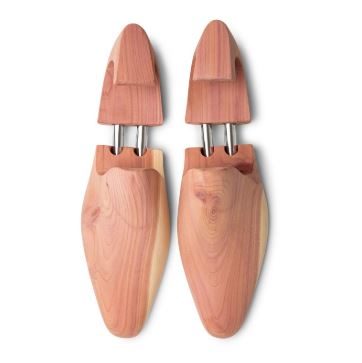
2. Split-Toe Wooden Shoe Trees
- Best For: Everyday dress shoes
- Why: Adjustable width, fits a range of shapes
- Example Brands: Stratton, Skolyx, La Cordonnerie Anglaise
3. Boot Trees with High Shaft Support
- Best For: Chelsea boots, chukka boots, or any tall footwear
- Why: Helps retain shape of both foot and shaft area
- Example Brands: Hanger Project, Bexley
4. Travel Shoe Trees
- Best For: Use in luggage or while on the go
- Why: Lightweight, maintains basic shape temporarily
- Note: Not a full replacement for daily shoe trees at home
Frequently Asked Questions
What are spring-loaded shoe trees?
Spring-loaded shoe trees are generic shoe inserts made with a front block, a metal spring, and a small heel knob, designed to maintain shoe shape.
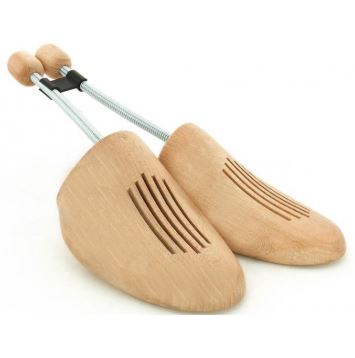
Why are spring-loaded shoe trees considered harmful?
They apply uneven pressure, especially vertically, which can deform the vamp and heel over time, leading to long-term damage.
How do these shoe trees affect the vamp area?
They push the vamp upward unnaturally, stressing the leather and stitching, and potentially leading to permanent distortion.
What damage can occur at the heel?
The heel knob concentrates pressure on the heel counter, causing it to bulge or collapse, especially in leather-structured heels.
Are spring shoe trees ever useful?
Their only minor benefit is reducing creasing slightly, but the risks far outweigh the advantages for most leather shoes.
What’s the main design flaw of spring-loaded trees?
They are one-size-fits-all and rely on a strong spring, which creates force in unnatural directions instead of providing balanced support.
What type of shoe trees should be used instead?
Full wooden shoe trees with a contoured shape and horizontal tension are best for preserving the shoe’s original structure.
Why is horizontal tension important?
It smooths out creases across the vamp and provides support without distorting the shoe’s natural shape or structure.
How do proper shoe trees support the heel?
They use a full heel block that distributes pressure evenly, helping retain the shape and fit without damaging the heel counter.
Is it better to skip shoe trees than use spring-loaded ones?
Yes, if a proper fit isn’t available, skipping them is often safer than using spring-loaded trees that can cause harm.
Can poor shoe tree use affect shoe comfort?
Absolutely. Warped heels and stretched vamps can lead to discomfort, poor fit, and uneven wear during walking.
What features should you look for in a good shoe tree?
Look for anatomical shape, size-specific fit, solid heel support, and wood material that absorbs moisture and odors.


